By Joe D’Aleo, CCM and Dr. Madhav Khandekar
As reported by the AP, “Carbon dioxide emissions were 35 percent higher in 2006 than in 1990, a much faster growth rate than anticipated, researchers led by Josep G. Canadell, of Australia’s Commonwealth Scientific and Industrial Research Organization, report in Tuesday’s edition of Proceedings of the National Academy of Sciences. The changes “characterize a carbon cycle that is generating stronger-than-expected and sooner-than-expected climate forcing,” the researchers report.” Alan Robock, associate director of the Center for Environmental Prediction at Rutgers University, added: “What is really shocking is the reduction of the oceanic CO2 sink,” meaning the ability of the ocean to absorb carbon dioxide, removing it from the atmosphere. The researchers blamed that reduction on changes in wind circulation, but Robock said he also thinks rising ocean temperatures reduce the ability to take in the gas.”
As we showed in an earlier blog, though estimates of man’s output of carbon dioxide have increased in the last two decades, the rate of increase in the atmosphere has not increased, implying the opposite, a “missing sink” or underestimated ability of nature, primarily the oceans, to remove the excess carbon dioxide, the exact opposite of what Robock at Rutgers and the alarmists at CSIRO are implying. Never mind they are ignoring the fact that there has been no warming globally in the last 9 years.
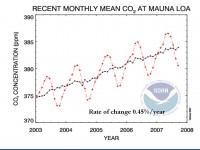
See in this blog the real story about carbon dioxide increases, how they relate to El Nino and La Nina and volcanic activity, that the oceans are cooling and not warming and why with a moderate La Nina underway, the rate of increase this year will probably drop dramatically.
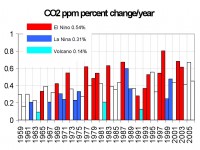
Wild Santa Ana winds – some of them reaching hurricane force—have been whipping through Southern California since early Sunday, October 21, triggering massive wildfires. Although this is the start of the area’s typical Santa Ana season, these winds have lasted longer than usual and have wreaked havoc because the area is in the midst of a lengthy drought. NASA Earth-observing satellites monitor our planet’s climate patterns. Bill Patzert, a climatologist with NASA’s Jet Propulsion Laboratory in Pasadena, Calif., says the drought is intensified by a climate pattern called La Nina—a pool of cool water in the Pacific near the equator that steers the jet stream to the north.
Cut 1- JPL Climatologist Bill Patzert explains where the wild Santa Ana winds originated that have been plaguing southern California and fueling the fires.
Running time: :30 Play audio
“Beginning this past Sunday, a great high pressure system, quite intense and quite deep, formed to the north of us and settled into the Great Basin, what is really known as Nevada. And the great clockwise circulation sent very intense winds spinning off the high desert through the great mountain passes of Southern California. As those winds dropped into the basin, the air compressed, it dried out, it heated up and it speeded up.”
Cut 2 - Bill Patzert says this is just the beginning of Santa Ana Season.
Running time: :18 Play audio
“Santa Anas are a winter phenomenon, and they often peak in December or January and so we’re just at the beginning here and unfortunately we’ve seen an exceptionally dry 18 months in Southern California so we’re super-duper fueled up.”
Cut 3 – Bill Patzert says the California drought is linked to a climate pattern called La Nina, in which a cool pool of water lingers near the equator.
Running time: :12 Play audio
“La Nina I often call ‘The Demon Diva of Drought.’” Eight out of 10 years when the La Nina is present in the Pacific are dry winters in Southern California.”
By World Climate Report
The findings by the UK judge announced last week that Al Gore’s An Inconvenient Truth failed to tell the whole truth on more than a few occasions received a fair degree of press coverage and, of course, a great deal of outcry from Gore defenders worldwide.
Now, “the Gore Team” has come to its own defense on a Washington Post blog site. In running down the list of supposed “errors” in An Inconvenient Truth, it is the basic contention of the Gore team that the scientific issues that Gore was trying to get a cross to a lay audience were far more complex than he had the time (or desire?) to adequately explain in a 90-minute feature film (or in the accompanying 328 page book; hint, use a smaller, albeit less dramatic, typeface next time).
Ultimately, the Gore Team has the following to say, acting dismayed at the state of media coverage these days, “To conclude, it’s unfortunate that news coverage of the UK decision was so sensational and, once again, directed conversation away from a broader and much-needed discussion and debate about solutions to the climate crisis.”
So sensational?! Apparently showing photo after photo of current and potential future environmental catastrophe (carefully ignoring instances of similar catastrophes in the past) while talking and writing in grave tones about climate change and mankind’s role in it, but never admitting that many other factors are also at play and in many cases are the dominant ones, is a perfectly acceptable way of conveying issues to the public. But, pointing out that this is what is going on is “sensational.”
It seems to us, that the Gore Team is just a bit miffed that someone stole a page out of their playbook and successfully ran it against them. See full story here.
By Dave Hoopman, Wisconsin Energy Cooperative News
A growing pile of record daily highs from the National Weather Service (NWS) office at Tucson International Airport (in the late 1980s) —and the absence of corresponding new records from Davis-Monthan Air Force Base on very similar terrain just three miles away—suggested a problem with NWS monitoring equipment, specifically with a device called the HO-83 hygrothermometer, newly installed at the airport in 1986. In the early 1990s, articles in the scientific and technical literature (starting with Gall 1992) began examining design flaws that might cause any HO-83 to read significantly higher than the real ambient air temperature and to produce higher readings the longer it remained in service.
It is common practice for records of the U.S. Historical Climatology Network (USHCN) to be adjusted to account for biasing factors such as differing times of recording data or changes in the location of monitoring equipment. But the USHCN records are evidently not adjusted to compensate for measurement errors introduced by the HO-83.
One reason for that could be that the HO-83 is installed at just 5 percent of the USHCN’s 1,221 monitoring stations, the vast majority of which are not NWS offices but rather are sited on private property and operated by citizen volunteers. Even so, in 1995 Thomas Karl, current head of the USHCN’s parent organization, the National Climatic Data Center (NCDC), and a strong proponent of the theory of human-induced climate change, authored a paper indicating replacement of older equipment with the HO-83 may have polluted the record of U.S. maximum temperature averages since the 1980s, raising them by an error of as much as 0.5 degree, Celsius.

Read more of this story which goes on to detail problems with this and other new instrumentation and highlights the work and findings of Anthony Watts.
See also the Climate Audit Blog on this issue.
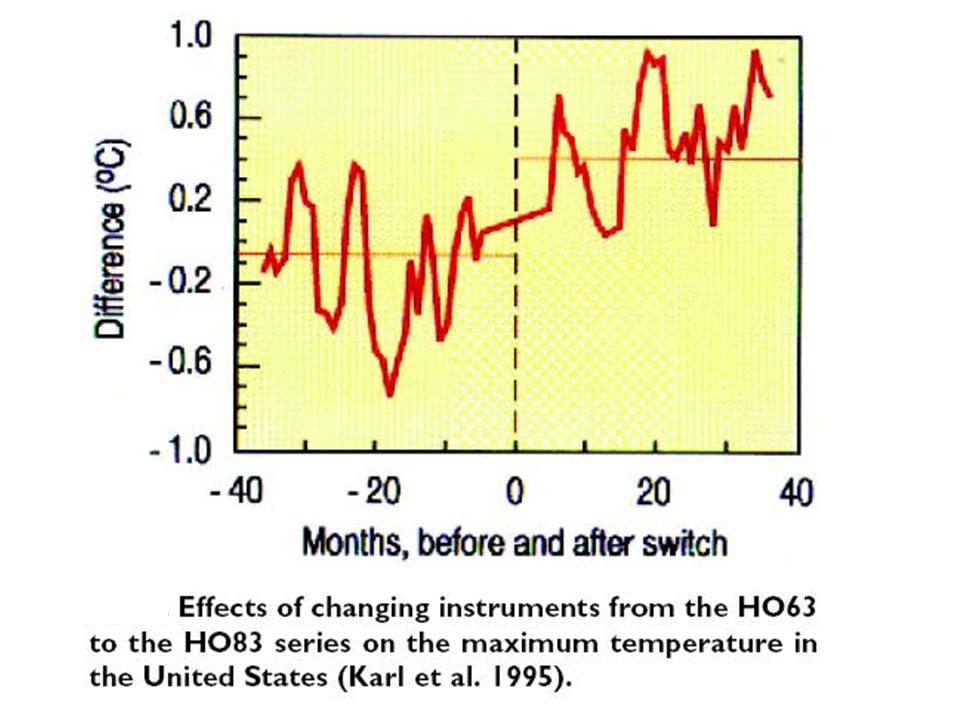
By Joseph D’Aleo, CCM, ICECAP
Recently, a critical adjustment was made by NASA to its US Annual mean temperature record since 1895, due to discovering an error in their adjustments found by Steve McIntyre, who also blew the whistle on the flawed hockey stick of Mann, Bradley and Hughes. Tellingly, the adjustment came without a press release or even an explanation on the site, sparking considerable attention in the blogosphere but drawing little mention in the national media. One can rest assured had the adjustment been the other way (a warming), there would have been press releases, widespread hype and headlines for several days.
The adjustment made was primarily to the temperatures in the years post 2000 for which the average year declined by 0.15C. NASA GISS’s Gavin Schmidt and James Hansen have responded to the media that the adjusted downward correction of 0.15 deg C (0.27F) was not significant. If one accepts that as true and examines the new US temperature curve since 1930, one finds a trend of only 0.12C (0.22F) for the 77 years of measurement. Thus, according to the recent judgment of Schmidt and Hansen’s, the warming in the United States over the past 77 years has also been “insignificant”.
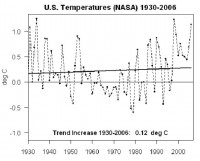
With NASA’s revised data base, 6 of the top 10 warmest years now fall within the span from the 1920s to 1950s, and only 4 in the last two decades.
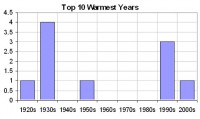
In the blog we go on to look at a case study, New York’s Central Park. We find very large differences between the raw observed data and the adjusted data sets for the US and global data sets (up to 11F). These kinds of huge variances in the “data” for one location raise serious questions as to whether we can trust any surface station based data set to determine changes the order of a tenth of a degree for climate change assessment and policy prescriptions. See the blog on the SPPI site here.
By Alexandre Aguiar,MetSul Weather Center Communications Director and the weatherman for Ulbra TV in Porto Alegre, Brazil
It was exactly 10 years ago today. October 14th 1997. The guest in the El Nino Community Preparedness Summit in Santa Monica, California, was the Vice President of the United States Al Gore. It was another opportunity to him to propagate the scary vision of a warmed globe. The main point was the super El Niño event of that year. Gore took advantage of the scene to forecast a future without La Niña events. El Niño events, according to him and his fellow scientists, would become permanent. “For those who argue that global warming is already changing the world’s climate, this year’s El Nino weather front is more than enough evidence”, the audience was told by Gore. In the next day, a report by the San Francisco Chronicle said: “Gore links El Niño to Global Warming”. The Vice President stated at the summit that growing frequency of El Niño episodes could be connected to the gradual heating of the atmosphere caused by emissions of carbon dioxide and other greenhouse gases.
October 14th 2007. Gore is the most celebrated name worldwide. He got an Oscar, then an Emmy and just two days ago a Nobel Peace Prize. There are no more awards to win. He got all. But there is an inconvenient truth to Mr. Gore exactly ten years after that conference in Santa Monica. An ironic truth. The same Pacific that makes Santa Monica one of the most attractive places in California is answering to the claims it would be permanently warm in a global warming era. Gore’s theory bankrupted exactly ten years after its release. The largest ocean in Earth is much colder than average and global climate starts to feel the impacts of a moderate La Niña event that may reach the strong threshold.
NOAA’s Multivariate ENSO Index for September reached its lowest value for that month of the year since 1988. It was the second largest one-month drop on record for this time of year. The -1.1 value was last seen in late 1999 and early 1989. According to the RSS MSU satellite data, September 2007 was the 7th coldest month among 81 months since January 2001. It has made it to the 9% of the coolest months of the 21st century so far, ICECAP reported. The Southern hemisphere was 0.015 Celsius degrees cooler than the long-term average, fifth coldest month since January 2001. Brazil’s MetSul Weather Center chief-meteorologist says this is clear evidence that Joe D’Aleo and other scientists claim that the higher frequency of El Niño events promoted global warming and not the contrary is correct. “Al Gore declared ten years ago that El Niño episodes were a consequence of global warming while historic data prior and after that claim shows El Niño is in fact a cause of warming since the Great Pacific Shift in the 70’s”, said meteorologist Eugenio Hackbart. MetSul Meteorologia expert also stated there is no coincidence that this La Niña of 2007 is taking place right during the 11-year solar minimum cycle. “Major La Niña events were recorded around the solar minima in the last decades”, said Eugenio Hackbart. It will take some more years to “Mother Nature” to dismiss some or all of Gore forecasts, but earlier predictions made by him are already proving to be an inconvenient mistake. See The story at METSUL here.
By Bob Ferguson, SPPI
Despite the lack of any trends in hurricane landfalls along the U.S. and Florida coasts, or damage to U.S. coastlines when population demographics are taken into account, the impact from a single storm can be enormous. The massive population and infrastructure build-up of the US coastline has vastly raised the potential damage that a storm can inflict. It is stunningly dishonest and irresponsibly dangerous to insinuate, let alone assert, that CO2 mitigation policies could cage the destructiveness of nature, particularly in hurricane-prone Florida.
Far and away the most important determinant in future vulnerability is not changes to climate or hurricanes themselves, but changes to the population and wealth structure of Florida’s coastal communities. The best available scientific evidence suggests that natural variations, on time scales ranging from years to decades, dominate any small impacts that a warming climate may have on the frequency and intensity of Atlantic tropical cyclones. Far and away the most important determinant in future vulnerability is not changes to climate or hurricanes themselves, but changes to the population and wealth structure of Florida’s coastal communities, many of which rank among the fastest growing localities in America, having increased five-fold since the mid-20th century (U.S. Census Bureau, 2006).
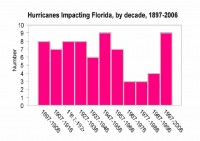
Read full detailed analysis here.
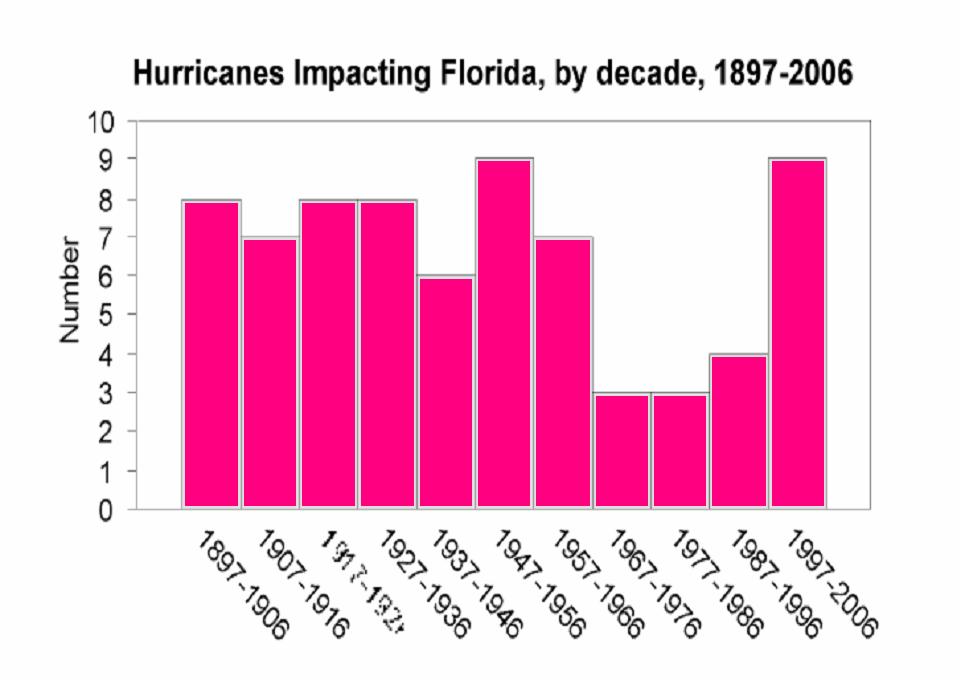
By James Woudhuysen, professor of forecasting and innovation, De Montfort University
Environmental activists and commentators frequently argue that climate change is the most pressing problem facing humanity, and that if we don’t do something about it the planet will burn up. Yet when planet-sized technological solutions to global warming – also known as ‘geo-engineering solutions’ – are put forward, environmentalists are the first to balk. ‘It will never work’, they say. Why are those who are most concerned about climate change also the most hostile to doing something serious to tackle it?
It isn’t just because such solutions would be ambitious, costly and distant in time; nor is it only because these solutions would carry risks. Rather, environmentalists tend to dismiss geo-engineering because, at root, they are not interested in halting climate change. For many today, both green activists and leading politicians, climate change is a moral and political issue rather than simply a practical problem. They see the ‘issue of climate change’ as a means to changing people’s behaviour and expectations, rather than simply as a byproduct of industrialisation that ought to be tackled by technological know-how. They are resistant to geo-engineering solutions because putting an end to climate change would rob them of their raison d’être.
Environmentalists instinctively reject or ignore technological solutions to global warming because they are bent on making people atone for their sins. Their ridicule of geo-engineering reveals that, for them, climate change is a moral tale about humanity’s greed and arrogance, where the happy ending is a much-reduced human population where everyone lives simply and meekly. Read more here.
By Joe D’Aleo, CCM, ICECAP
In a recent guest blog, John McLean explained how Australia’s CSIRO and Bureau of Meteorology (Power and Smith) respectively were reporting a period of unprecedented El Niño dominance the last 30 years, which they blamed on human activity. Last year in May it was Vecchi who told us there was a just 1% probability that this was due to natural events. On The Weather Channel blogs, meteorologist Stu Ostro, also found a similar continuity shift in weather pattern starting 30 years ago. Blog comments back to Stu and John McLean’s blog here showed how the change had precious little to do with anthropogenic factors but was a large scale cyclical climate shift known for decades as the Great Pacific Climate Shift and in more recent years as a phase change in what has come to be known as the Pacific Decadal Oscillation.

In this analysis, we show how these are simply changes resulting from multidecadal oscillations in both the Pacific and Atlantic. In addition we show how these cycles correlate extremely well with temperatures in the United States and the arctic. These cycles likely also are responsible for the recent decline in arctic ice as was previously observed in the 1930s and 1940s when arctic temperatures last peaked.
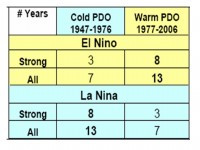
See full analysis in pdf format here
Also see paper on Anthony Watts blog “Watts Up with That” by retired California State Climatologist Jim Goodrich on the PDO, solar and California climate.
By Luboš Motl, Pilsen, Czech Republic in The Reference Frame
According to the new RSS MSU satellite data, September 2007 was the 7th coldest month among 81 months since January 2001. It has made it to the 9% of the coolest months of the 21st century so far. Their gadgets measure temperature at latitudes between -70.0 (S) and +82.5 (N) - about 94.5% of the surface if I compute well.
In the last month, the global temperature was just 0.12 Celsius degrees above the long-term average which means that it was 0.78 Celsius degrees cooler than the temperature in April 1998 when the anomaly was +0.9 Celsius degrees. The main reason is La Nina that is getting stronger and might continue to do so for a few months.
The Southern hemisphere was 0.015 Celsius degrees cooler (!) than the long-term average, fifth coldest month since January 2001. Antarctica has cooled down by roughly 1 Fahrenheit degree in the last 50 years. See Lubos’s blog here.
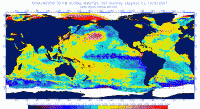
By World Climate Report
Imagine if a large hurricane struck New York City during this tropical cyclone season – the devastation would be incredible and during and following the disastrous event, global warming would undoubtedly be blamed for the all that happened to the Big Apple. Believe it or not, this will happen sometime in the not-so-distant future, it’s a virtual lock! New York City has been struck many times in the past by tropical cyclones, and it is just a matter of time before another hurricane passes directly over the city.
As we have detailed many times in the past, there is a considerable debate in the climate community regarding the future of hurricane activity. Nonetheless, should a large hurricane pass over downtown Manhattan, scientists promoting the greenhouse link would breathlessly appear on our televisions 24 hours a day.
A recent article in Geochemistry, Geophysics, Geosystems by geological scientists at Brown University and Woods Hole Oceanographic Institution focuses on hurricanes in New York City (well, western Long Island). Four documented strong hurricanes (Category 2 or higher on the Saffir-Simpson Scale) with high storm surges (~3 meters) have made landfall in the New York City area since 1693 with the last occurring in 1893. They correctly note in terms of any linkage with sea surface temperatures (SSTs), “Interestingly, several major hurricanes occur in the western Long Island record during the latter part of the Little Ice Age (~1550–1850 A.D.) when SSTs were generally colder than present. According to paleoclimate estimates, SSTs were likely 2 °C cooler than present in the Caribbean, 1°C cooler than present in the Florida Keys during the latter part of the Little Ice Age, and 1°C cooler than present during the 17th and 18th centuries at the Bermuda Rise.” Read full report here.
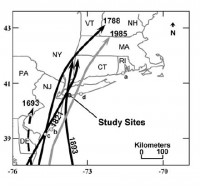
Most significant Big Apple landfalls occurred in 1693, 1788, 1821, and 1893.
By Dennis Avery in News By Us
I was invited to testify before the Senate environment committee September 26, on “The Impact of Global Warming on the Chesapeake Bay.” I told the committee there was no man-made global warming impact on the Bay. The Bay has been warmer than now several times because the moderate 1,500-year climate cycles have warmed it at least five times since the Bay was created 12,000 years ago. At least two of those cycles, and perhaps all of them, were warmer than today. Our net global warming since 1940 is 0.2 degrees C, with no warming at all since 1998. There’s no evidence that man-made CO2 has added much to this warming, though perhaps 0.1 degree C of today’s heat is due to the greenhouse gasses. The 1,500-year cycle is instead linked to the sun and the sunspot index. Nor has a single wild species gone extinct due to higher temperatures. Instead, the birds, butterflies , trees, fish and mammals have been extending their ranges, creating more biodiversity per acre than the world has seen in 500 years.
None of the Senators asked me about the cycle, the solar linkage or the wildlife. You never saw such an eager crowd of man-made warming enthusiasts. Chairperson Barbara Boxer of California waxed eloquent about her Committee’s recent trip to the Arctic, where she said the evidence of man-made warming was impossible to miss. She chided Republican James Inhofe because the extent of Arctic ice had just dropped to its lowest point since the 1930s. She failed to mention that this couldn’t be global warming--because the Antarctic ice has just hit a modern high. This is regional climate cycling, which the Polar Regions are known for. Read more here.
Shrinkage of the North Polar Ice Cap and Pole-to-Pole TeleconnectionsGuest Blog by Dr. R.J. Johnson, University of Minnesota
We now have a beautiful (but tricky) example how warming is affected the oceanic climate system. The rapid loss of North Polar perennial sea ice is now well documented. Two large areas of ice have been lost in the east and west Asian sectors in the last five years. In addition, the main outflow of ice from the polar region in the East Greenland current (brown arrow) today extends half way down the coast of Greenland, whereas in 2002 the seasonal flow had hardly started.
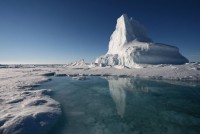
The increased outflow of ice and water is consistent with a recent Scandinavian report of increasing flow of the Norwegian current into the Arctic Ocean, and contrasts with the report of the Woods Hole oceanographers that the deep outflow from the Greenland Sea (that forms the conveyor belt) was slowing. But it all makes sense, what goes in must come out somewhere, and if less deepwater comes out while the Norwegian Current is increasing, much more water must come out on the surface, and that water contains the meltwater from annual net loss of perennial ice. And the larger flow of low salinity water of the Greenland Current inhibits deepwater formation and the deep outflow that normally results.
Read more here about the polar ice cap and the Antarctic and why the changes may eventually lead to a new glaciation regardlesss of any increasing carbon dioxide.
Guest Blog by John McLean
Hardly a day goes by without a new claim about a human influence on climate. In the last 18 months we’ve been told, not once but three times, that the air circulation across the tropical Pacific is slowing down and it’s all our fault.
The problem is that the scientific papers making those claims have somehow managed to completely ignore the Great Pacific Climate Shift of 1976 despite this being well-known to climatologists. The changes caused by that climate shift can account for the altered circulation pattern. Despite what the three papers say we don’t need to include any human influence.
Was the omission of the Climate Shift deliberate or accidental through ignorance? Neither is particularly palatable in such a controversial field where we expect, but don’t always get, impartial and accurate science.
Of course such an omission in peer-reviewed papers doesn’t reflect well on the reviewers and journals in question, but many of us are used to that bias by now.
See the full analysis here.

In full support of John’s thesis is the above plot of Mantua’s PDO since 1950 with a predominance of the cold phase (La Nina (blue spikes)) until 1976 and then the warm phase (El Nino (red spikes)) after
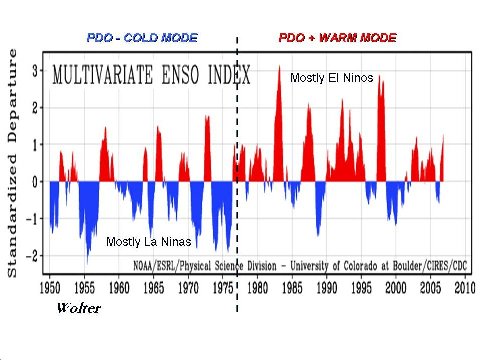
By Lubos Motl, The Reference Frame
The members of the global warming movement have offered us another piece of evidence that their thinking and behavior is not too different from the Nazis and communists. The State Climatologist of Virginia and one of the most esteemed U.S. climate scientists, Prof Patrick Michaels, was effectively stripped of his title.
Environmentalist activists complained that Michaels’ opinions could be interpreted as the official climatological opinions of the state of Virginia. Well, it was my understanding that this was exactly the very purpose of the chair of the state climatologist. Who else should determine the key answers about the climate in that state?
But the green scum simply didn’t like Michaels’ conclusions. So they just fired him through a disgraceful governor, Mr Tim Kaine, and replaced him with a Philip “Jerry” Stenger. Let’s now look what scientific credentials were sacrificed in the name of an ideology. Google’s Scholar finds 411 articles with Michael’s name and those that he co-authored have hundreds of citations. Among 9 papers with the name of Stenger, only a few were co-authored by Stenger and all of those have Michaels on the author list, too. Nevertheless, the total citation count of Stenger seems to be 1 citation.
For purely ideological reasons, the quality of the office of the State Climatologist of Virginia was reduced by nearly three orders of magnitude. As a reader says, sharp scientists are being replaced by party officials. Much like the activists in Germany of the 1930s, these people are plain mad. They never realize that a possible decision could simply be over the edge. They are ready to do absolutely anything and everything for their silly unscientific ideology.
Read more of Lubos’s blog here.




